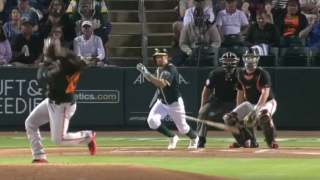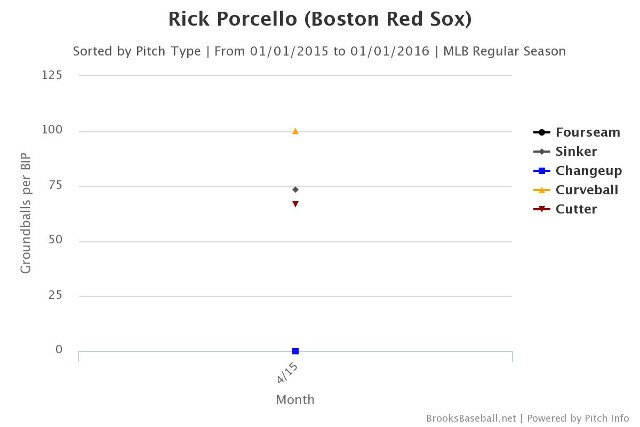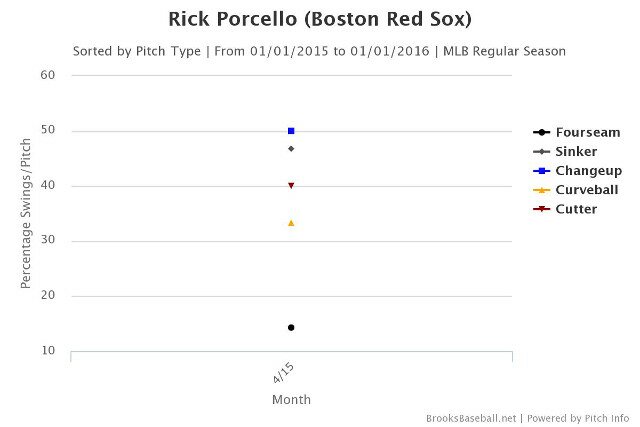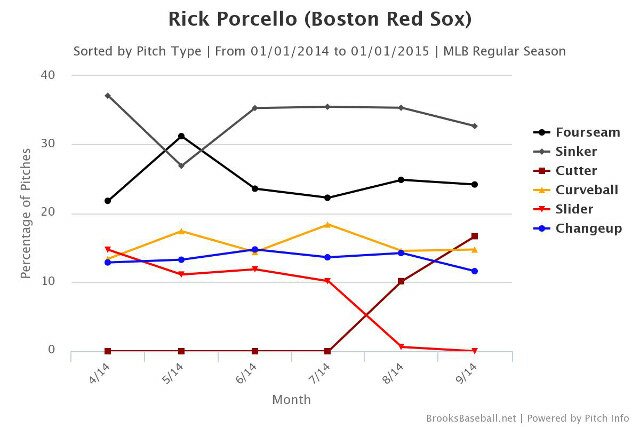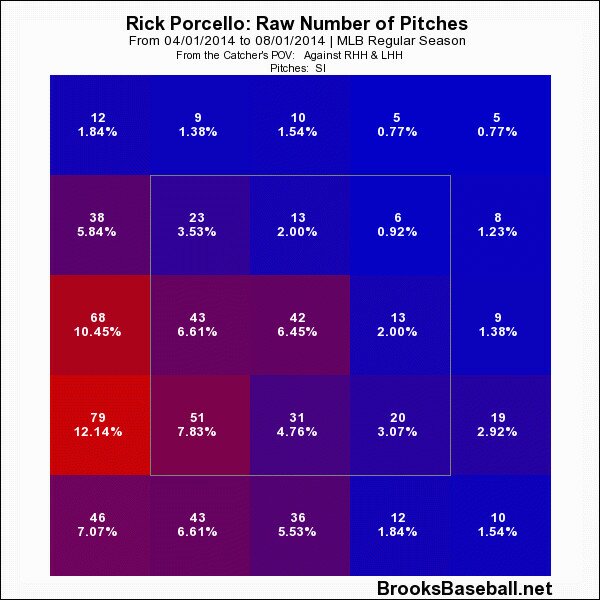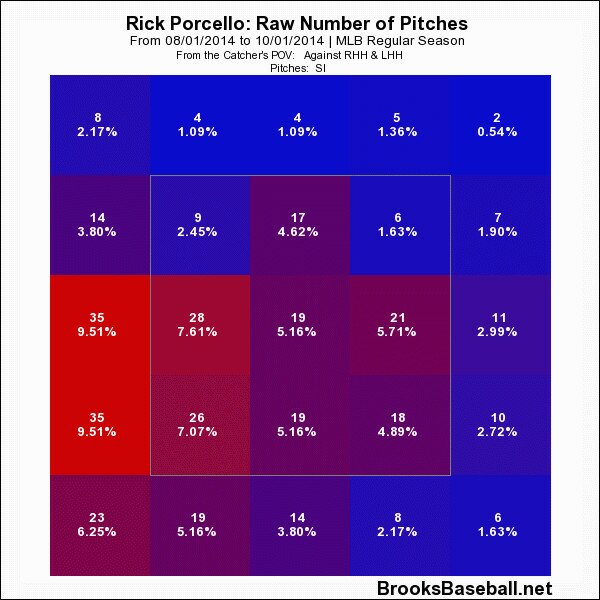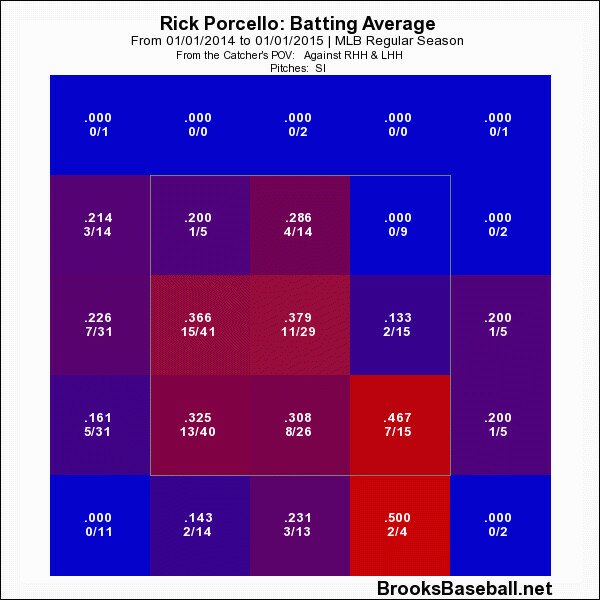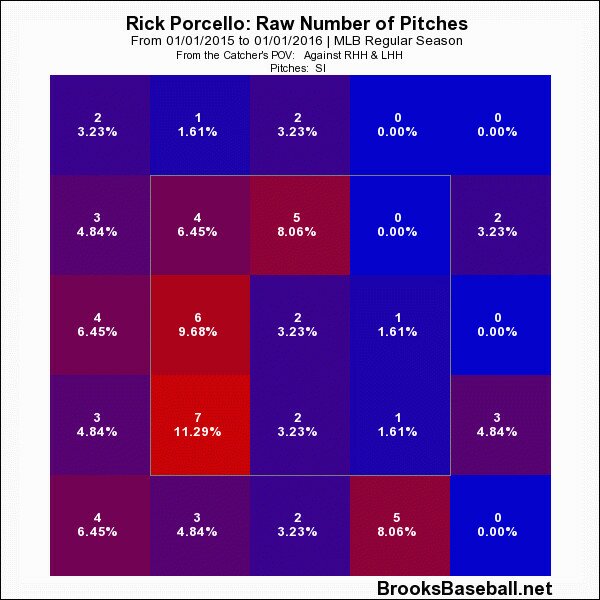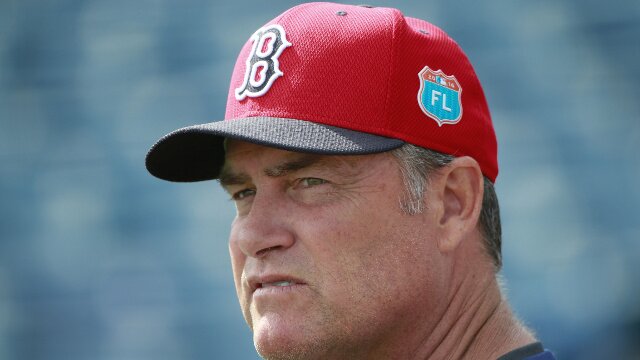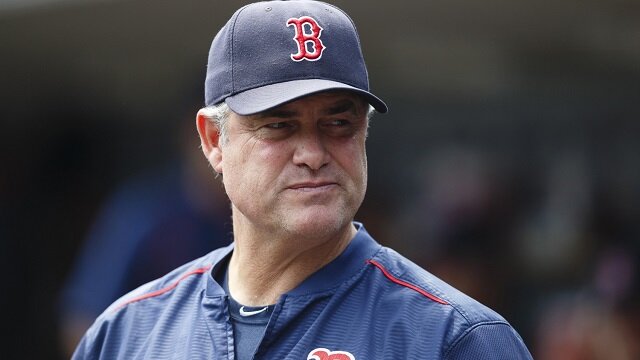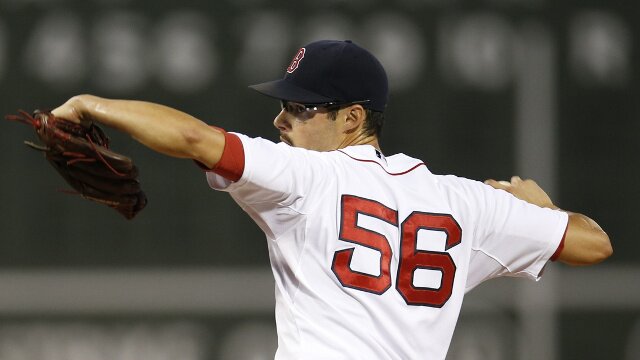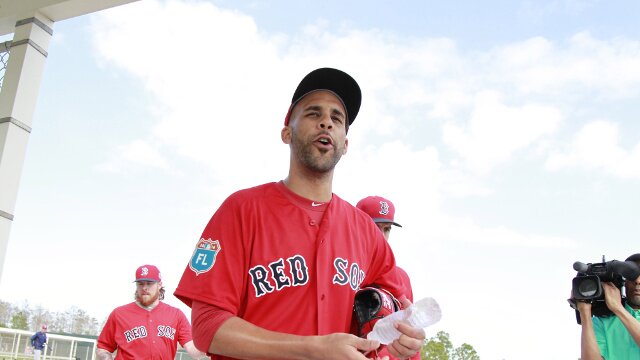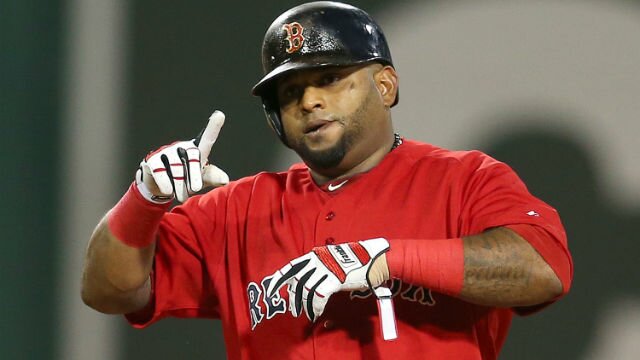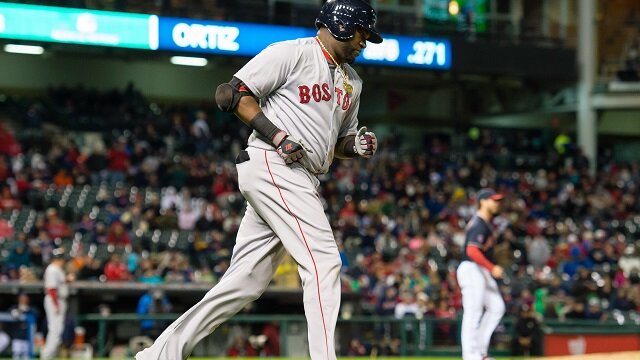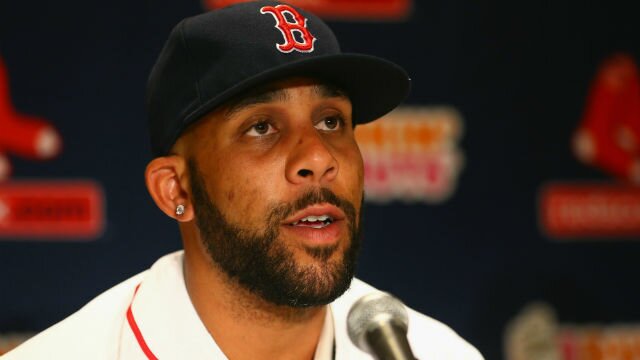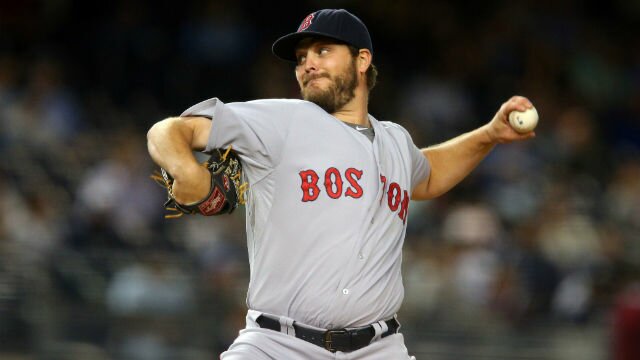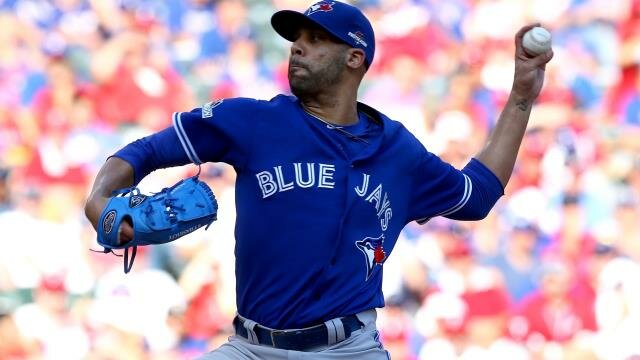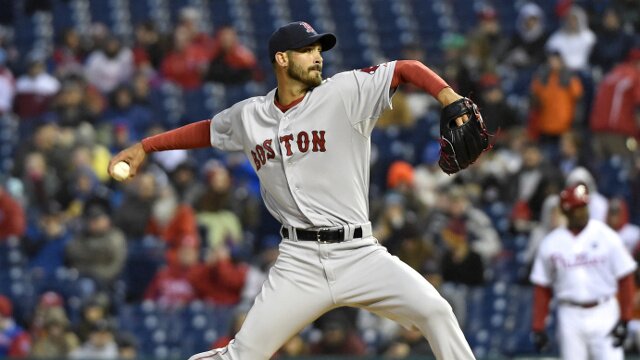
Last Wednesday, Rick Porcello made his Boston Red Sox debut against the Philadelphia Phillies on the heels of the news that he had signed a four-year, $82.5 million contract extension. The 26-year-old New Jersey native, who spent the first six years of his career with the Detroit Tigers before moving to Boston in the Yoenis Cespedes deal back in December, ultimately took the loss after going six innings, allowing six hits, three earned runs, two walks and recording four strikeouts.
All three runs came as the by-product of a Jeff Francoeur home run in the sixth inning. If it hadn’t been for that one mighty swing of the bat, Porcello may have actually had a very nice night. Nevertheless, there were still more than a few positives to take away from the young right-hander’s outing.
Porcello threw a total of 101 pitches, 62 of which were sinkers, meaning that he used the pitch 61.39 percent of the time. Given the success he has had with the sinker in the past, it was hardly a surprise to see Porcello show a tremendous amount of confidence in his signature pitch while making his first start with his new team.
In 2014, which many consider to be Porcello’s best season to date even though he had a forgettable month of September, his sinker generated a GB/BIP rate of 58.15, a remarkable four-year low. Over at Fangraphs, where it is classified as a two-seam fastball, the pitch was given a PITCHf/x value of 8.0 runs above average, which was more than three runs higher than any one of his other pitches.
With an overall career ground-ball rate of 52.2 percent, it would be more than fair to say that Porcello is at his best when he keeps the ball on the ground, and his sinker is obviously one of his best tools in helping him accomplish that. As a matter of fact, his sinker may have been sinking just as much, if not more than ever on Wednesday night.
As seen in the chart below, the pitch was generating ground balls per BIP at a rate of 73.33 against the Phillies.
Of course, the Phillies are no longer the offensive juggernaut that they once were and they did manage to get a few hits off of the pitch, but they weren’t hitting for any power against it. Through the one start, opponents are currently hitting .278 with a .278 slugging percentage against the sinker, per Brooks Baseball.
So, how did they fare against his other pitches?
Well, the sample size is tiny considering the fact that he only threw nine of them, but Porcello’s curveball actually generated grounders at a rate of 100 percent per BIP in the start. However, the curve yielded a 56.32 GB/BIP rate from opponents last season, making it his second-best ground-ball-inducing weapon, so it certainly isn’t much of a fluke that the curve was working well for him on Wednesday night.
Porcello’s cutter, on the other hand, appears to be somewhat of a mystery pitch.
While Porcello only threw only 15 cutters, one of them was the pitch that Francoeur hit out of the park. The pitch essentially hung right over the heart of the plate (leading many to call it a hanging slider), allowing Francoeur to put a nice swing on it, driving it over the fence. It is also interesting to note that the Phillies were fairly aggressive against the cutter, swinging at 40 percent of them.
The changeup and sinker still generated the highest percentage of swings, but the cutter was seemingly given more attention than the curveball and four-seamer. The cutter is actually a relatively new addition to Porcello’s arsenal. Going back to last season, it is quite interesting to note that he didn’t even begin throwing the pitch until August.
Initially, the results were not very good, with opponents hitting .318 with a .546 slugging percentage against the cutter in August. The implementation of the cutter also coincided with a near-subtraction of the slider, according to the chart above. He also began throwing it at around the same time opponents began finding more success against the sinker. While they weren’t necessarily hitting it for more power, they were certainly getting a few more hits off of it.
While opponents only hit .227 against the sinker from Apr.1 through Aug. 1, they were able to bat a stellar .307 against it in the final two months of the season. Part of that can also be explained by the fact that the BABIP on the pitch went from .242 to .368. Porcello still actually had an excellent August, but opposing batters were clearly hitting the sinker a bit better, which may have foreshadowed his September collapse.
On that note, let’s take a look at his pitch location. The following heat map shows where Porcello was placing the sinker when he was going well last season.
The next heat map shows that by the end of the year, there were a few more sinkers that were tailing out and over the plate to right-handed hitters and directly into a left-handed hitter’s wheelhouse.
Unsurprisingly, this is also the area where hitters had the most success against the pitch, as evidenced by the .467 BAA.
Perhaps this could be why the Phillies were so aggressive against the sinker on Wednesday night, thinking the pitch would be as hittable as it was towards the end of 2014. However, as seen in the final heat map, Porcello appeared to be better with his location on the pitch during that game.
When Porcello was going through his rough stretch in September, his cutter was oddly one of his better pitches, but opponents still hit a healthy .278 with a .333 slugging percentage against it.
In addition to his sinker, the four-seamer and changeup were being hit rather hard by the end of last season as well. His curve continued to be a nice weapon for him, however, generating a .222 BA and .222 slugging percentage in September, which could be why the Phillies simply wanted to leave that one alone. Plus, when they were swinging at it, they were pounding it into the ground.
So, while the jury may still be out on the cutter as it seems to be something of a work in progress, the biggest positive to take away from Porcello’s first start with the Red Sox is that the sinker is back and located properly, which is going to be vital to his success this season.
When coupled with his stellar curveball, Porcello could be an even bigger ground-ball machine this year. This will be more important than ever for him now that he is pitching in the offense-laden AL East. His changeup should be a decent pitch for him moving forward as well.
Porcello had the luxury of pitching his home games at spacious Comerica Park over the first six years of his career, but he will need to be a little bit more careful on balls in the air at Fenway, especially those that are hit to left field. Porcello has a career fly-ball rate of just 27.6 percent, but he has allowed a relatively high 11.3 percent HR/FB. He did post a career-best mark of 9.5 in that department a season ago, which is something that the Red Sox would like to see him sustain.
Plus, it is not only Fenway; other parks in the AL East, such as Yankee Stadium, Camden Yards and Rogers Centre have been known to be rather amenable to the home run ball as well.
Although Porcello struck batters out at a rate of 7.22 K/9 back in 2013, his career mark in that department is only 5.50, so strikeouts are not exactly his specialty either. To put it simply, inducing ground balls has been, and will continue to be one of the biggest keys to his success. The Red Sox should have a solid infield with Pablo Sandoval, Xander Bogaerts, four-time Gold Glover Dustin Pedroia and Mike Napoli, which would benefit Porcello compared to the defense he had in Detroit.
Some have raised questions about whether or not Porcello will be able to live up to his new aforementioned contract extension, which is certainly fair. After all, most of his career numbers, such as his 4.30 ERA, 4.03 FIP, 3.87 xFIP and a 4.03 SIERA, appear to be quite average on the surface, but he is now going to be paid like an ace or No. 2 starter.
While Porcello will still be making $12.5 million in 2015, he will be earning over $20 million annually each year from 2016-19 ($20.125 million in 2016 and 2017 and $21.125 million in 2018 and 2019, per Baseball Reference). The question that frequently comes up in baseball circles regarding a new signing or contract extension these days is the issue of how much a win above replacement is worth. While there is ongoing debate, most place the number anywhere between $5-7 million at this point in time.
So, by using the top figure of seven, being a 3.0 fWAR player on an annual basis would put Porcello’s value right at $21 million. Thus far, Porcello has never been able to cross the 3.0 fWAR barrier, but he has been close, posting marks of 2.7, 2.8 and 2.7 over the past three seasons respectively.
Plus, considering the fact that Porcello made tremendous strides last season before hitting a wall in September, it is hard to fault the Red Sox for taking a chance here. Sure, Tigers fans expected big things out of Porcello ever since the day he was drafted in the first round of the 2007 draft (No. 27 overall), and some may be inclined to argue that he has already had plenty of time to show that he could live up to the hype, but he is still remarkably only 26 years old.
If Porcello ends up having a big year, this contract may look pretty nice compared to what he would have otherwise garnered on the open market. If he can continue to throw his best sinker in the right location, every other pitch will follow, and Porcello may truly be primed for big things in 2015.
* All statistical information courtesy of Baseball Reference, Brooks Baseball and Fangraphs
Brad Faber is a Senior Writer and Sabermetrics Columnist for www.RantSports.com. Follow him on Twitter @Brad_Faber, “Like” him on Facebook or add him to your network on LinkedIn or Google.













